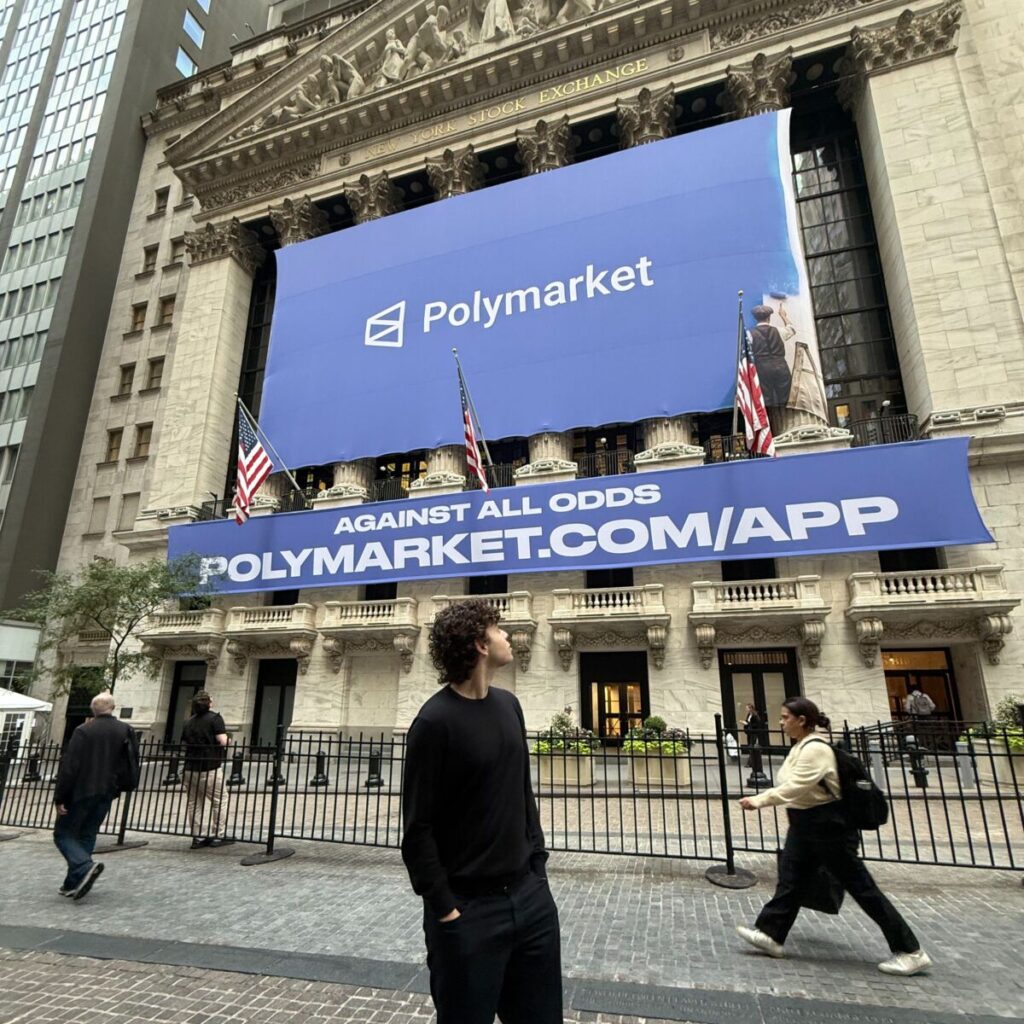
In a move that validates prediction markets as a legitimate financial asset class, Intercontinental Exchange Inc., owner of the New York Stock Exchange, announced today it will invest up to $2 billion in Polymarket, reflecting a valuation of approximately $8 billion pre-investment.
This isn’t venture capital money. This isn’t crypto-native funds. This is the owner of the NYSE making one of the largest investments in crypto-adjacent infrastructure to date. The implications are massive, for Polymarket, for competitor Kalshi, and for the broader narrative around blockchain-based financial products.
Let’s break down why this matters and what it means for traders in the crypto ecosystem.
1.The Deal: $2 Billion at $8-10 Billion Valuation
The details are striking. According to WSJ, the deal could value the prediction market platform at as much as $10 billion, with ICE investing up to $2 billion in Polymarket.
For context, Polymarket was founded in 2020, just five years ago. The investment follows a previous venture round that reportedly valued the prediction market at more than $1 billion. That means Polymarket went from unicorn to $8-10 billion valuation in under a year.
What ICE is buying:
Strategic equity stake – Up to $2 billion investment gives ICE significant ownership and board influence.
Global data distribution rights – ICE will become a global distributor of Polymarket’s event-driven data, providing this to institutional investors worldwide through ICE’s existing infrastructure.
Tokenization partnership – The companies will partner on future tokenization initiatives, suggesting blockchain integration beyond current Polymarket operations.
Market validation – ICE’s involvement legitimizes prediction markets as serious financial instruments rather than speculative gambling platforms.
2.Why Wall Street Wants In
ICE isn’t making this investment for charity, they see massive business opportunity in prediction markets. Here’s why:
2.1 Data as the Real Product
Prediction markets generate incredibly valuable data. When real money is on the line, aggregate predictions often outperform expert forecasts, polls, and traditional analysis.
ICE will become distributor of Polymarket data to institutional investors globally. This creates a new revenue stream: selling real-time prediction market data to hedge funds, investment banks, and institutional traders who use it for alpha generation.
Examples of valuable data:
– Election outcome probabilities more accurate than polls
– Fed policy predictions ahead of official announcements
– Corporate event likelihood (mergers, CEO changes, earnings)
– Geopolitical risk assessment (conflict probability, policy changes)
2.2 Diversification Beyond Traditional Exchanges
ICE’s core business—stock exchanges and derivatives trading—faces structural headwinds including declining trading commissions and increasing competition. Prediction markets represent a high-growth adjacent market where ICE can leverage existing infrastructure (market data systems, regulatory expertise, institutional relationships) while accessing new revenue streams.
2.3 Tokenization Future
The announcement specifically mentions partnering “on future tokenization initiatives.” This suggests ICE sees Polymarket’s blockchain infrastructure as a pathway into broader asset tokenization—bonds, equities, real estate, commodities.
If traditional finance is moving toward blockchain-based settlement, ICE just bought a proven platform processing millions in daily volume with established smart contract infrastructure.
3.Polymarket vs Kalshi: The Competitive Dynamic
This investment comes amid fierce competition with Kalshi, the CFTC-regulated prediction market that recently eclipsed Polymarket in monthly trading volume.
Market share battle:
Kalshi – Kalshi captured 62% of total volume in the on-chain prediction market sector from September 11-17, with weekly trading volume exceeding $500 million.
Polymarket – Despite losing volume leadership temporarily, Polymarket’s $8-10B valuation dwarfs Kalshi’s rumored $1-2B valuation, reflecting different strategic positioning.
The key difference: regulatory approach.
Kalshi’s model:
– CFTC-regulated exchange operating within U.S. financial framework
– Restricted to U.S. users with KYC/AML compliance
– Limited to approved contract types after regulatory review
– Slower to launch new markets but with regulatory clarity
Polymarket’s model:
– Crypto-native platform operating globally (excluding U.S. due to regulatory uncertainty)
– Users control funds in self-custodial wallets
– Permissionless market creation with broader topic coverage
– Faster iteration but regulatory gray zone in some jurisdictions

Polymarket:
– Valuation: $8-10 billion
– Regulation: Global, crypto-native
– Users: International (excluding U.S.)
– Markets: Permissionless creation
– Backing: ICE ($2B), crypto VCs
Kalshi:
– Valuation: ~$1-2 billion (estimated)
– Regulation: CFTC-regulated
– Users: U.S. only with KYC
– Markets: Approved contracts
– Backing: Traditional VCs
4.What This Means for Crypto Markets
ICE’s investment validates several crypto narratives that have been controversial:
4.1 Blockchain-Based Financial Products Are Real
When the NYSE owner invests $2 billion in a platform built on Polygon (Ethereum L2), it’s a clear signal that blockchain infrastructure works at institutional scale. This reduces skepticism around blockchain’s viability for serious financial applications.
4.2 Crypto Infrastructure Attracts TradFi Capital
We’ve seen this pattern before—Coinbase, Circle, Fireblocks, and others attracting major traditional finance investment. Polymarket is the latest example of TradFi seeing crypto infrastructure as the future, not a competitor to eliminate.
4.3 Tokenization Momentum Accelerates
The announcement’s mention of “future tokenization initiatives” suggests ICE plans to use Polymarket’s infrastructure for broader tokenization efforts. This could include traditional securities, commodities, or new financial products built on blockchain rails.
4.4 Data Markets on Blockchain Are Valuable
Polymarket proves that blockchain-based markets generate valuable data that institutions will pay for. This opens pathways for other crypto-native data businesses to attract traditional finance capital.
5.Trading Opportunities: MEXC’s Role
While Polymarket doesn’t have a native token yet, this development creates trading opportunities across the prediction market ecosystem.
Indirect exposure strategies:
Polygon (MATIC/POL) – Polymarket runs on Polygon. Increased activity from ICE partnership could drive MATIC demand for gas fees and ecosystem growth. MEXC offers deep MATIC liquidity for traders wanting Layer-2 exposure.
Related prediction market tokens – Other blockchain-based prediction market protocols (Augur, Gnosis) may see renewed interest as the sector gains legitimacy.
Ethereum ecosystem plays – As Polygon’s parent chain, Ethereum benefits from L2 success and validation. ETH remains fundamental infrastructure for prediction market settlement.
DeFi governance tokens – Prediction markets share infrastructure with DeFi protocols. Increased institutional attention on one often spills over to the other.
6.Prediction Markets on MEXC: What to Watch
MEXC’s extensive token listings make it ideal for tracking the prediction market narrative:
Direct plays:
– Monitor for potential Polymarket token launch (unconfirmed but possible post-ICE investment)
– Watch Kalshi-related tokens if they emerge
– Track other prediction market protocol tokens
Ecosystem plays:
– Polygon (POL) – Direct infrastructure for Polymarket
– Ethereum (ETH) – Base layer security and settlement
– Chainlink (LINK) – Oracle services for prediction market data
– DeFi blue-chips – Shared infrastructure and user base
Market opportunities:
– Narrative-driven pumps when prediction market news breaks
– Correlation trading between prediction accuracy and related assets
– Event-driven volatility around major prediction market topics
MEXC advantages for this:
Fast listing speed – If Polymarket launches a token, MEXC’s rapid listing process captures early momentum
Deep liquidity – Large orders in MATIC, ETH, and ecosystem tokens execute with minimal slippage
Advanced tools – Stop-losses, limit orders, and portfolio tracking essential for volatile narrative-driven trading
Multiple exposure options – Spot, futures, and margin trading for different risk profiles
7.The Regulatory Question
Polymarket’s biggest challenge remains U.S. market access. The platform currently excludes U.S. users due to regulatory uncertainty, despite being founded by American entrepreneurs.
ICE’s involvement could change this:
Regulatory credibility – ICE operates heavily regulated businesses and understands how to navigate CFTC, SEC, and other oversight bodies.
Lobbying power – ICE has significant influence in Washington and could advocate for prediction market regulatory clarity.
Compliance infrastructure – ICE can provide compliance systems, KYC/AML processes, and regulatory reporting that satisfy U.S. requirements.
Structured products – ICE might create regulated derivatives based on Polymarket data, providing U.S. investor exposure without direct platform access.
If Polymarket gains U.S. market access while maintaining its global crypto-native approach, the platform’s valuation and usage could explode beyond current levels.
8.What Institutional Adoption Looks Like
This is what mainstream crypto adoption actually looks like, not retail FOMO, but institutional capital deploying billions into crypto infrastructure.
The pattern:
- Crypto-native companies prove product-market fit with real users and revenue
- Traditional finance recognizes the business model works at scale
- TradFi deploys capital to gain exposure, integrate infrastructure, or acquire capabilities
- Regulatory acceptance follows institutional involvement
- Mainstream adoption accelerates
We saw this with Coinbase going public, Circle partnering with BlackRock on USDC, and now ICE investing $2B in Polymarket.
9.Trading the News: Immediate and Long-Term
For MEXC traders, this news creates both immediate and sustained opportunities:
Immediate reactions (hours to days):
– MATIC likely sees volume and price increase as Polymarket infrastructure gains attention
– Broader market sentiment boost for Ethereum ecosystem tokens
– Prediction market competitors see speculative interest
Medium-term catalysts (weeks to months):
– Potential Polymarket token announcement driving anticipation
– ICE integration details revealing scope of partnership
– Kalshi response potentially including fundraising or strategic partnerships
– Regulatory developments as ICE navigates U.S. prediction market framework
Long-term structural shifts (quarters to years):
– Prediction markets becoming standard institutional data source
– Tokenization initiatives expanding ICE’s blockchain involvement
– Traditional exchanges integrating blockchain infrastructure more broadly
– Regulatory clarity enabling U.S. prediction market access
For position trading, the strategy is accumulating ecosystem exposure (MATIC, ETH) during dips while remaining nimble for potential token launches or partnership announcements.
10.The Bottom Line: Validation from the Top
When the owner of the New York Stock Exchange invests $2 billion in a crypto-based platform, it’s more than just a funding round—it’s a statement that blockchain-based financial products are real, valuable, and here to stay.
Key takeaways:
Prediction markets are legitimate – ICE’s involvement moves the sector from fringe speculation to recognized financial instruments.
Blockchain infrastructure works at scale – Polymarket processes millions in daily volume on Polygon, proving L2 viability for institutional use cases.
Data is the real business – More than trading fees, prediction market data has intrinsic value to institutional investors.
Ecosystem opportunities exist – MATIC, ETH, and related tokens benefit from increased attention and adoption of their infrastructure.
MEXC provides access– Fast listings, deep liquidity, and advanced tools position MEXC traders to capitalize on prediction market narrative momentum.
Polymarket went from crypto experiment to $10 billion valuation backed by Wall Street in five years. That trajectory reveals how 8quickly crypto-native business models can achieve mainstream validation when they solve real problems with working technology.G
For traders tracking where crypto is heading, prediction markets just became required watching,and MEXC provides the platform to act on that insight.
Disclaimer: This content is for educational and reference purposes only and does not constitute any investment advice. Digital asset investments carry high risk. Please evaluate carefully and assume full responsibility for your own decisions.
Join MEXC and Get up to $10,000 Bonus!
Sign Up


